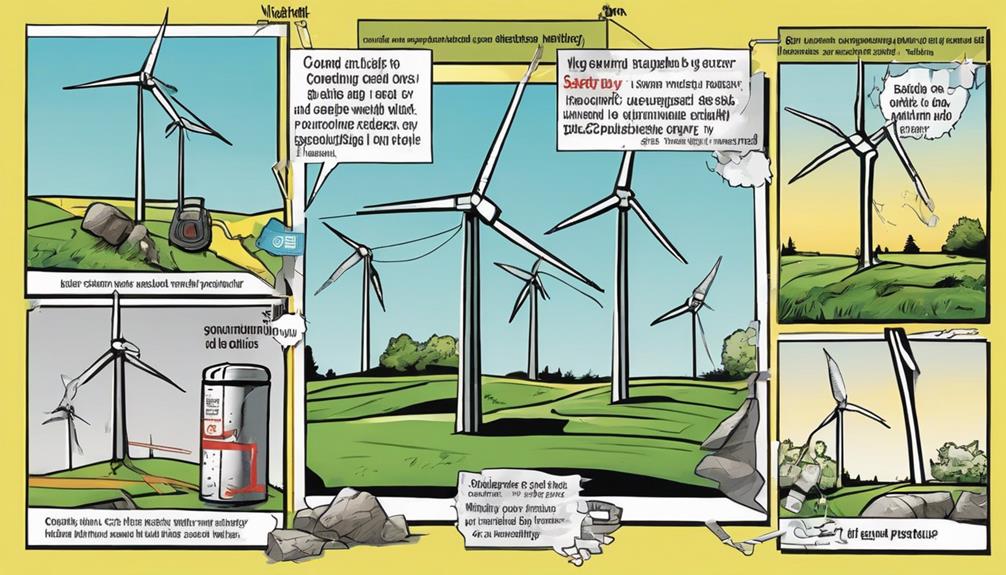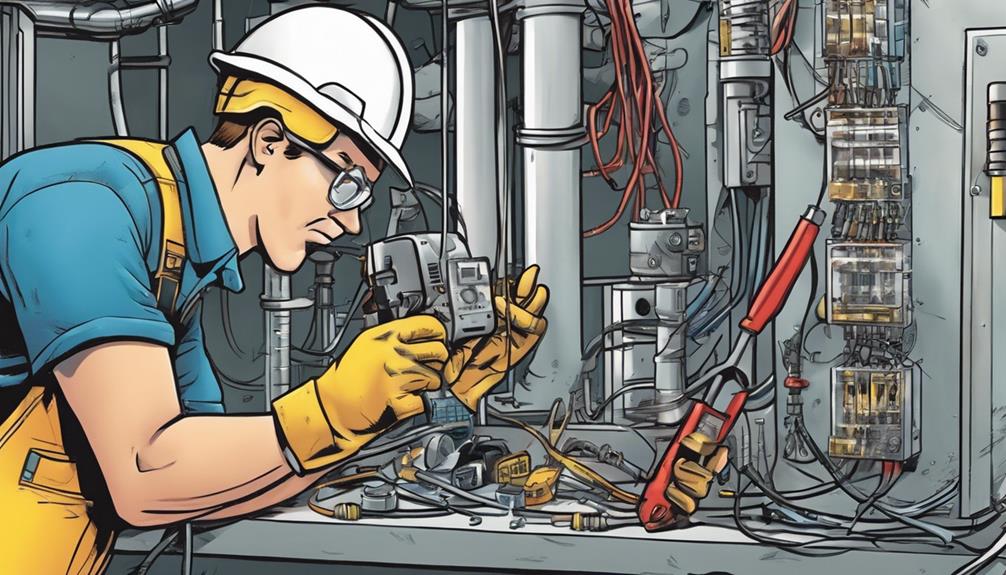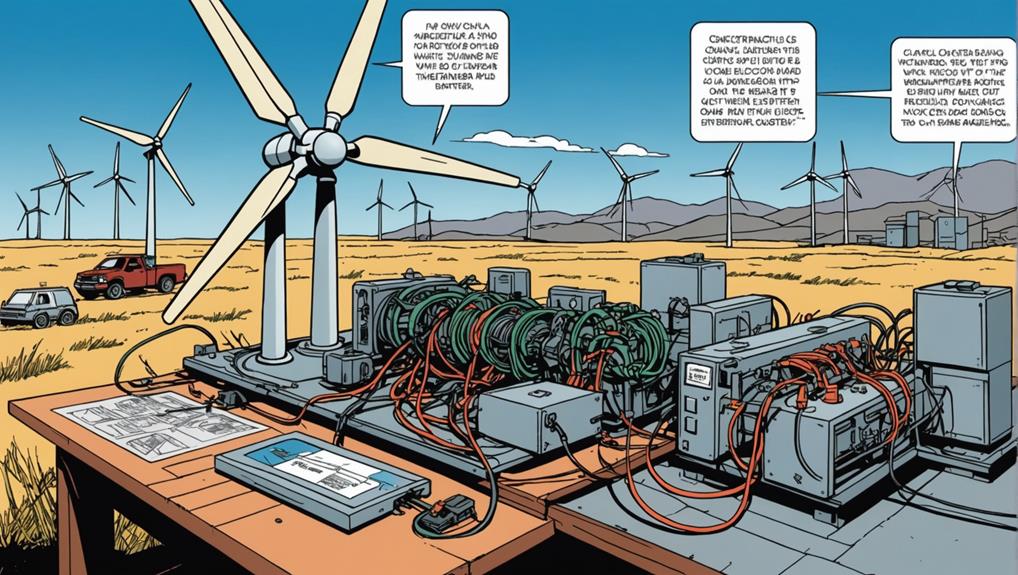To connect a wind turbine to a battery, match voltage output to battery needs. Confirm suitable cables and charge controller for regulation. Monitor temperatures and currents closely. Program wind turbine controller within safe limits. Use diversion charge controller for excess energy. For efficient charging, use compatible charge controllers and monitor battery temperatures. Verify turbine controller's voltage output regularly. MPPT controllers enhance charging. Track current, battery temps, and system performance. Install grounding rods for safety. Monitor consistently for essential power delivery. Utilize tools for efficient operation. Remember, each step is crucial for a successful wind turbine battery connection.
Key Takeaways
- Match turbine voltage output with battery requirements.
- Use suitable cables and charge controller for regulation.
- Monitor battery temperatures and charging currents.
- Program wind turbine controller within safe voltage limits.
- Consider diversion charge controller for excess energy.
Wind Turbine Selection
Choosing the appropriate wind turbine involves considering various factors such as power output, materials, and performance in different wind conditions. When selecting a wind turbine, the power output is a significant aspect to assess. Confirm that the turbine's power output, which typically ranges from 400W to 1500W, aligns with your energy requirements to effectively charge your battery system.
Efficient alternators within the wind turbine are vital for optimal energy conversion. Seek turbines with durable blades made from materials like fiberglass or carbon fiber to withstand varying wind speeds.
Another important factor to evaluate is the start-up wind speed of the wind turbine. Understanding the minimum wind speed required for the turbine to begin generating power can help you determine its suitability for your location. Additionally, consider the cut-in speed, which indicates the wind speed at which the turbine starts producing usable power. By examining these parameters, you can ensure that the wind turbine performs effectively across different wind conditions.
Charge Controller Installation

When connecting a wind turbine to a battery, it's important to ensure proper installation of a suitable charge controller for effective regulation of the charging process.
The charge controller, also known as the wind turbine controller, plays a pivotal role in preventing overcharging of the battery bank by controlling the electricity flow from the turbine.
Ensuring the correct installation of the charge controller is crucial to safeguard the battery and enhance the charging efficiency of the wind turbine system. This component acts as a key player in managing the energy transfer from the wind turbine to the battery, promoting safe and efficient operation.
Selecting the appropriate charge controller, such as an MPPT controller, is indispensable for maintaining the longevity and performance of the battery bank.
Properly installing the charge controller is essential in maximizing the functionality and protection of the entire wind turbine system.
Battery Connection Process

You need to verify that your battery is compatible with the power output of the wind turbine for best performance.
Implement efficient charging methods to maximize energy storage and utilization.
Regularly monitor your system's performance to maintain its efficiency and longevity.
Battery Power Compatibility
To ensure proper battery power compatibility in the connection process, it's important to match the wind turbine's voltage output with the requirements of the battery bank. This guarantees that the battery receives the correct voltage for efficient charging without risking damage due to overcharging or undercharging.
When connecting the wind turbine to the battery bank, use appropriate cables and a charge controller to regulate the charging process. Additionally, consider employing a diversion charge controller to manage any excess energy generated by the wind turbine, preventing potential harm to the batteries.
It is essential to monitor battery temperatures and charging currents closely, especially when dealing with lead-acid or lithium batteries, to prevent overheating and overcharging. Properly programming the wind turbine controller to operate within safe voltage limits for the battery bank is crucial for maximizing efficiency and extending the lifespan of the batteries.
Efficient Charging Methods
For efficient charging methods in connecting a wind turbine to a battery, make sure you use a charge controller compatible with your battery type.
When utilizing a wind turbine, a diversion charge controller is recommended to prevent overcharging and maximize battery performance.
It's essential to verify that the wind turbine controller is configured to the appropriate voltage output to safeguard the battery bank from potential damage.
Regularly monitoring battery temperatures, especially with lead-acid batteries, is necessary to avoid overheating caused by uncontrolled charging currents.
Additionally, considering the implementation of Maximum Power Point Tracking (MPPT) controllers for wind turbines can help optimize voltage and current levels, leading to more effective battery charging.
Monitoring System Performance
Efficiently monitoring system performance when connecting a wind turbine to a battery involves tracking charging current and battery temperatures for best operation.
To ensure consistent power delivery from the wind turbine and maintain the battery at an ideal state of charge, utilizing a monitoring system like docwattson is essential. The docwattson device enables tracking of turbine output, current flow, and battery health throughout the charging process.
It's particularly vital to keep a close eye on battery temperatures, especially with lead-acid batteries, to prevent overheating and potential damage. Proper monitoring of the wind turbine's performance is fundamental for both efficient energy production and battery maintenance.
Grounding and Safety Measures

Properly grounding your wind turbine system is essential for preventing electrical hazards and guaranteeing safety throughout installation and operation. Grounding rods, buried at least 8 feet deep in moist soil, create a reliable electrical ground connection.
Securely connecting grounding wires to the turbine structure, charge controllers, and battery bank helps dissipate excess electrical charge, reducing the risk of electrical malfunctions.
Regularly inspect and maintain the grounding system to protect equipment from lightning strikes and ensure continued safety.
Adhering to local electrical codes and regulations for grounding practices is vital for compliance and safe operation of your wind and solar system.
Monitoring System Efficiency

To effectively monitor the efficiency of your wind turbine system, utilize tools like docwattson to track turbine current and battery status. Monitoring system efficiency is crucial to guarantee consistent power delivery for charging the batteries and maintaining their health and performance.
Battery temperature monitoring is especially significant, particularly for lead-acid batteries commonly used in wind turbine systems. It's vital to keep an eye on the battery temperature to prevent overheating, which can markedly impact battery lifespan and efficiency.
Additionally, it's important to note that the compatibility of wind turbine alternators with solar combiner boxes may vary, necessitating careful monitoring to guarantee seamless integration.
Furthermore, Vertical Axis Wind Turbines (VAWTs) may face challenges in providing reliable power output long-term, which can directly influence the overall efficiency of the system.
Maintenance and Troubleshooting

Regular maintenance of wind turbine components such as blades, bearings, and wiring is important to guarantee peak performance. Inspecting and cleaning the turbine regularly can prevent debris buildup and secure efficient energy generation. Troubleshooting common issues like loose connections, damaged blades, or faulty controllers can help resolve performance problems.
Monitoring battery voltage levels and charging rates is vital to determine if the wind turbine is effectively charging the battery. Periodic checks on cables, connections, and grounding systems can help identify and address potential safety hazards. Using a solar charge controller or wind charge controller can optimize the charging process and protect the battery from overcharging. Additionally, incorporating a dump load can help regulate the turbine's output and prevent damage to the battery.
Frequently Asked Questions
Can I Charge a Battery Directly From Wind Turbine?
Yes, you can charge a battery directly from a wind turbine. Make sure you connect the wind turbine to a charge controller first. It regulates voltage and current to prevent battery damage. Proper setup and configuration are essential for efficient charging.
What Battery Do I Need for Wind Turbine?
When connecting a wind turbine, you need a battery that suits your system. Consider factors like cost, lifespan, and compatibility. Deep cycle batteries such as SOPzS or LiFePO4 are popular choices with varying benefits.
Can I Connect a 24V Wind Turbine to a 12V Battery?
Yes, you can connect a 24V wind turbine to a 12V battery by utilizing a voltage step-down converter or a charge controller. This setup efficiently matches the voltages, regulates charging, and safeguards the battery from damage.
Do Wind Turbines Run on Batteries?
Wind turbines do not run on batteries, but they can be connected to batteries for energy storage. This connection allows you to store excess energy generated by the turbine and use it when needed, enhancing efficiency.
Can I Connect a Wind Turbine to a Battery to Charge it?
Yes, you can definitely connect a wind turbine to a battery for charging battery with wind turbine. By installing a charge controller, you can regulate the power output from the turbine to ensure a steady and safe charging process for the battery. This is a great way to harness renewable energy for off-grid power solutions.
Conclusion
So, there you have it – connecting a wind turbine to a battery is as easy as pie! Just remember to follow these simple steps and you'll be harnessing the power of the wind in no time.
And if all else fails, just blame it on the weather – after all, Mother Nature can be quite the tricky partner in crime.
Happy wind turbine-ing!










